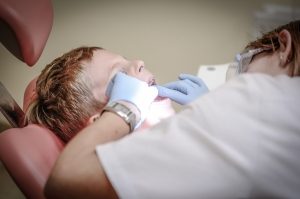By Nelle Gregory, RN, MPH
Many chronic health conditions and most dental diseases are preventable if we eat healthy foods, exercise, get good sleep, limit our stress, and practice good oral hygiene. Many of us have the information we need to make good decisions, so why do we sometimes

fail to follow our healthcare providers’ recommendations? To make changes in our behaviors, we must have the desire to act and move towards a goal…we must be motivated. For healthcare providers, it can be discouraging when patients fail to comply with their treatment recommendations. Research has shown that most of us have a hard time following our healthcare provider’s recommendations; knowledge is not enough to change behavior. It requires that healthcare providers move from simply sharing health information to building mutual respect that allows the patient to articulate his or her own solutions.
At community listening sessions conducted by The WNC Children’s Oral Health Initiative, parents said they do not know what good oral health looks like, when they should take their child to the dentist, where they could get care, what the standard care is, and how much it should cost. They do not have the basic information they need to make good oral health decisions… and it is impacting their ability to get their children into care. Many parents shared stories of feeling shamed and talked about being ‘blamed for their kids poor oral health.’ They discussed how this made them less likely to want to go back to the dentist.
The American Dental Association (Health Literacy in Dentistry, 2009) encourages the creation of a respectful and ‘shame-free’ dental environment. By helping patients identify their own reasons to change their behavior, they build trust in and respect for their healthcare provider and are more motivated to change. Motivational interviewing is one tool that helps healthcare providers support and encourage their patients’ readiness to change.
Motivational Interviewing (MI)
 Motivational interviewing (MI) is an evidence-based approach to behavior change that is grounded in a respectful conversation between provider and patient to identify a patient’s readiness for change, and that helps the patient come up with ideas about how they can strengthen their motivation to change. Making MI the foundation of anticipatory guidance assures that providers listen to the concerns of parents and children, understand their ambivalence to change, and support their ideas about change and what they think would work. In a dental setting, MI shifts the conversation from a one-way monologue about brushing their teeth and cutting down on sugar to a conversation about the parent and child’s experiences, challenges, and ideas about what needs to change and how the provider can support them in making the needed changes.
Motivational interviewing (MI) is an evidence-based approach to behavior change that is grounded in a respectful conversation between provider and patient to identify a patient’s readiness for change, and that helps the patient come up with ideas about how they can strengthen their motivation to change. Making MI the foundation of anticipatory guidance assures that providers listen to the concerns of parents and children, understand their ambivalence to change, and support their ideas about change and what they think would work. In a dental setting, MI shifts the conversation from a one-way monologue about brushing their teeth and cutting down on sugar to a conversation about the parent and child’s experiences, challenges, and ideas about what needs to change and how the provider can support them in making the needed changes.
The American Dental Association research has shown that the main reason people do not get dental treatment is due to cost and perceived need. The way providers counsel impacts their patients’ perceived needs. At one of the community listening sessions a parent shared that her dentist told her to ‘just do a better job brushing her daughter’s teeth,’ but the parent, whose child is autistic, said that she has a hard time getting her daughter to open her mouth, and brushing her teeth is the least of her worries. She left frustrated that her dentist had no understanding of autism, and her perceived need for dental services was low.
Research has shown that using MI in dentistry can lead to more lasting behavior change and improved oral health outcomes (Kay, 2016). Positive behavior change occurs more readily when healthcare providers connect the change with what the patient values – people are motivated to change when it impacts what they value rather than what someone else determines they need. Confrontational styles or persuasion are likely to build resistance and mistrust. When health providers try to persuade or give advice, patients often feel guilt or shame. Healthcare providers must abandon the impulse to solve their patient’s problems and allow them to articulate their own solutions. Our motivation is impacted by our culture, family norms, and the multitude of other issues we deal with in our daily lives. The parent of the autistic child shared that she just needed her dentist to listen to her, hear the challenges she faces when trying to care for her daughter’s oral health, empathize with her, give her suggestions the dentist had heard from other autistic parents on how to get her daughter to open her mouth, and work with her to figure out a better solution.
Learn More
The WNC Children’s Oral Health Initiative is partnering with MAHEC to develop MI training for dental professionals. If you want to get more information about the project or MI training, contact nelle.gregory@gmail.com.
About the WNC Children’s Oral Health Initiative
The Western North Carolina (WNC) Children’s Oral Health Initiative, with funding from The Duke Endowment, is working to improve children’s oral health. The project is coordinated by Mission Children’s Hospital and WNC Health Network and overseen by a Steering Committee of dentists, dental hygienists, physicians, public health providers, and community partners. The group completed an assessment of children’s oral health in 18 western counties in NC in 2017. They held parent listening sessions to hear concerns parents in WNC had about their children’s oral health. A strategic plan was developed that prioritized the concerns voiced by parents.
References
American Dental Association. Health Literacy in Dentistry: Strategic Action Plan 2010-2015. Council on Access, Prevention, and Interprofessional Relations. Chicago, IL, 2009.
Achison KA, Rozier RG, Weintraub JA. Integrating Oral Health, Primary Care, and Health Literacy: Considerations for Health Professionals Practice, Education and Policy. Commissioned by the Roundtable on Health Literacy, Health, and Medicine Division, the National Academies of Sciences, Engineering, and Medicine. Prepublication copy, 2018.
Kay EJ, Vascott D, Hocking A, Nield H. Motivational interviewing in general dental practice: A review of the evidence. British Dental Journal 2016; 221: 785-791


